Member of the National Academy of Sciences
Membership of the National Academy of Sciences is an award granted to scientists that the National Academy of Sciences (NAS) of the United States judges to have made “distinguished and continuing achievements in original research”.[1][4] Membership is a mark of excellence in science and one of the highest honors that a scientist can receive.[5][6][7][8][9]
| Member of the National Academy of Sciences | |
|---|---|
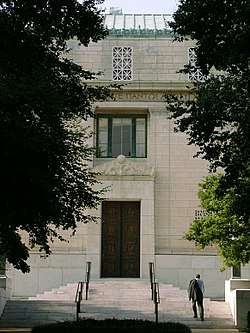 The National Academy of Sciences Building in Washington, D.C. | |
| Awarded for | distinguished and continuing achievements in original research[1] |
| Sponsored by | National Academy of Sciences |
| Date | Annually since 1863[2][3] |
| Location | Washington, D.C. |
| Country | United States |
| Total no. of members | 2,382 members 484 foreign associates[1] |
| Website | nasonline |
NAS members and foreign associates
Three types of NAS membership exist:[4][5]
- Voting members, who must hold citizenship of the United States
- Nonvoting foreign associates,[10] who have citizenship outside the United States
- Emeritus members, who are no longer active and have rescinded their voting rights
As of May 2018 there were 2,382 active members and 484 foreign associates,[11] of whom approximately 190 have received Nobel Prizes.[1] A full list of members can be found in the online members directory.[1] See the list of members of the National Academy of Sciences and Category:Members of the United States National Academy of Sciences for examples.
Notable member firsts
Some notable member firsts and records include:
- Edward C. Pickering (1846–1919)[12] was the youngest scientist elected, only 26 years old at the time of his election in 1873[13][14]
- Florence R. Sabin (1871–1953)[15] was the first woman to be elected a member in 1924[13]
- David Blackwell (1919–2010)[16] was the first African American elected in 1965[13]
- Marcia McNutt was the first woman to serve as president of the NAS,[17] following her election as a member in 2005.[18]
- Ben Barres (1954–2017)[19] was the first transgender scientist elected in 2013[20][21]
- Frances Arnold was the first woman to be elected to all three National Academies in the United States – the National Academy of Engineering (NAE, 2000), the National Academy of Medicine (NAM, 2004) and the National Academy of Sciences (NAS, 2008)[22]
- Richard Feynman resigned his NAS membership because of what he perceived as the Academy's elitism and in-group favoritism.[23][24] Feynman outlines the reasons for his resignation in his published correspondence Perfectly Reasonable Deviations from the Beaten Track.[23][24]
Member diversity
Critics have pointed to a lack of member diversity because of a selection bias for “old white men” who dominate membership of the Academy. Elite institutions such as the from Ivy League, MIT, Stanford, the University of California and Caltech also dominate membership,[25] thereby perpetuating the Matthew effect. Diversity of age, disability, race, religion, gender and sexual orientation is lower in NAS than in the general population.[9] For example, women in science are an underrepresented group in the Academy but the proportion of female members is slowly growing.[26][27][28]
- In 1989, the academy had just 57 female members and 1,516 male members (3% female in total)[29]
- In 2010, there were 14 newly elected women (19% new female inductees) from 72 new members[30]
- In 2011, there were only 9 women (12% new female inductees) from 72 newly elected members.[31][9][32]
- In 2012, the Academy elected 84 new members, with a record high of 26 women (30% new female inductees)[9]
- In 2019, 50 women out of 125 new members were female (40% of new female inductees), another record high[33][34] although the proportion of women in the academy as a whole is much lower than 40%[27]
Persons of color, African Americans and Hispanics are also underrepresented.[9][5] In 2019, the academy was considering expelling members for sexual harassment.[35][36][37][38]
Nomination and election of new members
New members and foreign associates have been elected annually since 1863.[2] Membership can not be applied for as only voting academicians can submit formal nominations for newly elected members, for preferential voting in an annual ballot of members every March.[4] Candidates for membership are considered by peer review and voted for again through several rounds of balloting[39] and a final annual ballot in April at the annual general meeting (AGM) of the academy with results announced shortly after, usually early May.[8][11] Each nomination includes a curriculum vitae (CV) with a 250 word summary of the nominee's scientific archievements, the basis for election and a list of no more than 12 of their most important papers published in scientific journals.[4] The publication limit of 12 aims to focus assessment on the quality of a nominee's work, rather than the quantity of publications.[4][5]
As of 2019, a maximum of 100 members may be elected annually. Non-citizens of the USA are elected as foreign associates, with a maximum of 25 elected annually. Both members and foreign associates are affiliated with one of six scientific disciplines:[4]
- Physical science and mathematical sciences
- Biological sciences
- Engineering and applied sciences
- Biomedical sciences
- Behavioural sciences and social sciences
- Applied Biological, agricultural science and environmental sciences
On election, members are invited to an annual awards ceremony.[40]
Member biographies
Since 1966, newly elected members of the National Academy of Sciences have been invited to contribute an inaugural year article (IYA) to Proceedings of the National Academy of Sciences of the United States of America (PNAS) which is accompanied by a brief biography of the author.[41] Biographies of deceased members are published in the Biographical Memoirs of the National Academy of Sciences (BMNAS), for example see David Arnett's biography of Alastair G. W. Cameron.[42]
Members gallery
A small sample of example members and their portraits is shown below, taken from the list of members of the National Academy of Sciences.
 Nobel laureate Albert Einstein was elected a member in 1942.[43] The Albert Einstein Memorial stands outside the NAS building
Nobel laureate Albert Einstein was elected a member in 1942.[43] The Albert Einstein Memorial stands outside the NAS building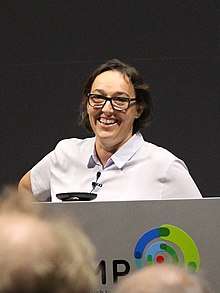 Molecular biologist Angelika Amon was elected a member in 2015[44]
Molecular biologist Angelika Amon was elected a member in 2015[44]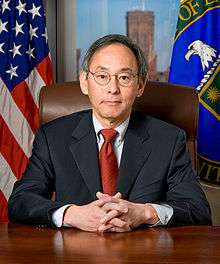 Nobel laureate Steven Chu was elected a member in 1993[45]
Nobel laureate Steven Chu was elected a member in 1993[45]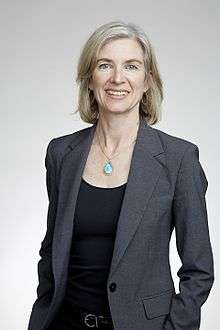
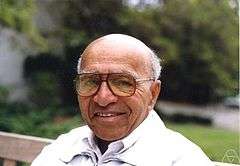
.jpg)

.jpg) Nobel laureate Frances Arnold was the first woman to be elected to all three National Academies of Sciences, Engineering, and Medicine in the US: the NAE in 2000, the NAM in 2004 and the NAS in 2008.[52][22]
Nobel laureate Frances Arnold was the first woman to be elected to all three National Academies of Sciences, Engineering, and Medicine in the US: the NAE in 2000, the NAM in 2004 and the NAS in 2008.[52][22]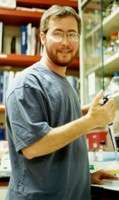 Neurobiologist Ben Barres was the first transgender scientist elected in 2013[20]
Neurobiologist Ben Barres was the first transgender scientist elected in 2013[20]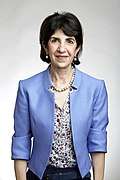
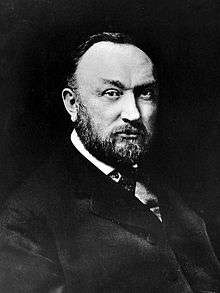 Astronomer Edward Charles Pickering[12] was the youngest scientist elected, only 26 years old at the time of his election in 1873
Astronomer Edward Charles Pickering[12] was the youngest scientist elected, only 26 years old at the time of his election in 1873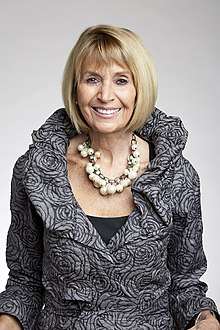 Geophysicist Marcia McNutt was elected a member in 2005 and has served as the 22nd president of the NAS since 2016[18]
Geophysicist Marcia McNutt was elected a member in 2005 and has served as the 22nd president of the NAS since 2016[18]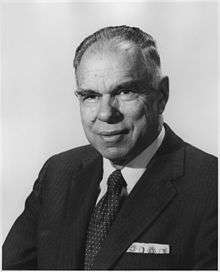 Nobel laureate Glenn T. Seaborg was elected a member in 1948[54]
Nobel laureate Glenn T. Seaborg was elected a member in 1948[54]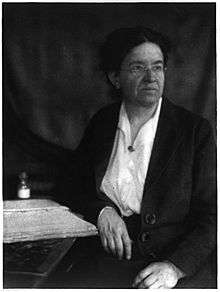 Medical scientist Florence R. Sabin was the first woman to be elected in 1924[15]
Medical scientist Florence R. Sabin was the first woman to be elected in 1924[15]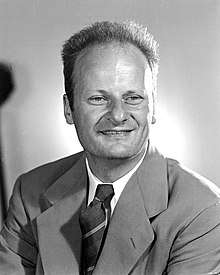 Physicist Hans Bethe was elected a member in 1944[55]
Physicist Hans Bethe was elected a member in 1944[55]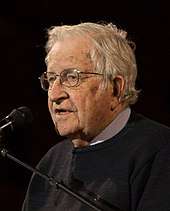 Polymath Noam Chomsky was elected a member in 1972[56]
Polymath Noam Chomsky was elected a member in 1972[56]- Psychologist Elizabeth Loftus was elected a member in 2004.[57]
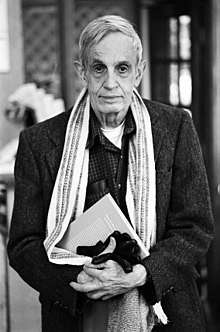 Mathematician John Forbes Nash Jr. was elected a member in 1996[58]
Mathematician John Forbes Nash Jr. was elected a member in 1996[58]
References
- Anon (2019). "About NAS membership". Nasonline.org. National Academy of Sciences. Archived from the original on 2019-03-20.
- Olson, Steve (2014). "The National Academy of Sciences at 150". Proceedings of the National Academy of Sciences. 111 (Supplement_2): 9327–9364. doi:10.1073/pnas.1406109111. ISSN 0027-8424. PMC 4077050. PMID 24958885.
- "Overview: NAS History". nasonline.org. Retrieved 25 April 2019.
- Anon (2019). "NAS Member Directory". nasonline.org/member-directory. Archived from the original on 2019-04-18.
- Alberts, Bruce; Fulton, Kenneth R. (2005). "Editorial: Election to the National Academy of Sciences: Pathways to membership". Proceedings of the National Academy of Sciences. 102 (21): 7405–7406. doi:10.1073/pnas.0503457102. ISSN 0027-8424. PMC 1140467. PMID 16586925.
- Anon (1997). "Newly Elected Members and Foreign Associates of the National Academy of Sciences April 29, 1997". Proceedings of the National Academy of Sciences. 94 (9): 4235–4236. doi:10.1073/pnas.94.9.4235. ISSN 0027-8424. PMC 33659. PMID 16578853.
- Anon (2001). "New Members and Foreign Associates Elected to the National Academy of Sciences on May 1, 2001: 72 New Members Chosen by the Academy". Proceedings of the National Academy of Sciences. 98 (10): 5387–5388. doi:10.1073/pnas.101188198. ISSN 0027-8424. PMC 33222. PMID 16578859.
- Anon (2000). "New Members and Foreign Associates Elected to the National Academy of Sciences on May 2, 2000. 60 New Members Chosen by the Academy". Proceedings of the National Academy of Sciences. 97 (10): 5037–5038. doi:10.1073/pnas.100999997. ISSN 0027-8424.
- Shen, Helen (2013). "US science academy celebrates 150 years: President Ralph Cicerone discusses diversity and efficiency at the National Academy of Sciences". Nature. doi:10.1038/nature.2013.12530. ISSN 1476-4687.
- Wilson, Edwin B. (1953). "Vital Statistics of our Foreign Associates". Proceedings of the National Academy of Sciences. 39 (12): 1295–1298. doi:10.1073/pnas.39.12.1295. ISSN 0027-8424. PMC 1063952. PMID 16589414.
- Anon (2018). "May 1 2018 NAS Election". nasonline.org. Retrieved 25 April 2019.
- "Edward Pickering". nasonline.org. Retrieved 25 April 2019.
- Anon (2019). "Membership FAQ". nationalacademies.org. National Academies of Sciences, Engineering, and Medicine. Archived from the original on 2018-03-05.
- Archibald, Raymond Clare (1936). "The Youngest Member Elected to the National Academy of Sciences". Science. 83 (2158): 436–437. doi:10.1126/science.83.2158.436-a. ISSN 0036-8075. PMID 17820127.
- "Florence Sabin". nasonline.org. Retrieved 25 April 2019.
- "David Blackwell". nasonline.org. Retrieved 25 April 2019.
- Lavelle, Marianne (2015). "Science Editor-in-Chief Marcia McNutt set to become first woman to lead U.S. National Academy of Sciences". Science. doi:10.1126/science.aac8806. ISSN 0036-8075.
- Nair, Prashant (2017). "QnAs with Marcia McNutt". Proceedings of the National Academy of Sciences. 114 (13): 3272–3274. doi:10.1073/pnas.1703235114. ISSN 0027-8424. PMC 5380059. PMID 28298528.
- Nair, Prashant (2015). "QnAs with Ben Barres". Proceedings of the National Academy of Sciences. 112 (33): 10074–10075. doi:10.1073/pnas.1512539112. ISSN 0027-8424. PMC 4547303. PMID 26240349.
- Anon (2013). "Neurobiologist Becomes First Transgender Scientist Selected For U.S. National Academy of Science Membership". transnews.org. Trans Media Network. Archived from the original on 2018-10-02. Retrieved 2019-04-25.
- "Ben Barres". nasonline.org. Retrieved 25 April 2019.
- Anon (2018). "Frances Arnold Wins 2018 Nobel Prize in Chemistry". caltech.edu. California Institute of Technology. Retrieved 2018-10-04.
- Toumey, Chris (2005). "SPT v8n3 – Reviews – Feynman Unprocessed". vt.edu. Virginia Tech. Archived from the original on 2019-03-19.
- Feynman, Richard; Feynman, Michelle (2005). Perfectly reasonable deviations from the beaten track : the letters of Richard P. Feynman. New York: Basic Books. ISBN 0738206369. OCLC 57393623.
- Leiter, Brian (2018). "Top 50 universities by membership in the National Academy of Sciences". typepad.com. Archived from the original on 2019-04-29.
- Spake Zuska, Thus (2007). "NAS Deigns to Admit 9 Women This Year". Scienceblogs.com. ScienceBlogs. Archived from the original on 2019-04-25.
- Chivers, Tom (2016). "This Is How Many Women Are Members Of Science Academies". Buzzfeed.com. BuzzFeed. Archived from the original on 2017-06-29.
- "Women in Science". nasonline.org. Retrieved 25 April 2019.
- "News of the week from the science world". The San Francisco Examiner. May 20, 1989. p. D-2 – via newspapers.com.
- Hoopes, Laura (2010). "National Academy of Sciences List for 2010". nature.com. Archived from the original on 2019-03-24.
- Montell, Gabriela (2007). "Only 9 Women Are Elected to the National Academy of Science". chronicle.com. The Chronicle of Higher Education.
- Hoopes, Laura (2011). "National Academy of Sciences Picks Few Women Again". nature.com. Archived from the original on 2019-03-24.
- "2019 NAS Election". www.nasonline.org.
- Jaschik, Scott (2019). "Record Number of Women Join Academy of Sciences". insidehighered.com. Inside Higher Ed.
- Wadman, Meredith (2018). "Will U.S. academies expel sexual harassers?". Science. doi:10.1126/science.aau3229. ISSN 0036-8075.
- Wadman, Meredith (2019). "In lopsided vote, U.S. science academy backs move to eject sexual harassers". Science. doi:10.1126/science.aax8773. ISSN 0036-8075.
- Reardon, Sara (2019). "US science academy leaders approve plan to expel sexual harassers". Nature. 569 (7755): 168. doi:10.1038/d41586-019-01397-y. ISSN 0028-0836. PMID 31065080.
- "2019 Bylaws". www.nasonline.org.
- Ruksznis, Elizabeth (1996). "Getting in: A Look at the Election Process Of the National Academy of Sciences". psychologicalscience.org.
- "2019 NAS Presentation Ceremony". youtube.com. YouTube.
- Cozzarelli, N. R.; Fulton, K. R.; Sullenberger, D. M.; Coughlin, B. C. (2003). "Biographies of newly elected Academy members". Proceedings of the National Academy of Sciences. 100 (23): 13117. doi:10.1073/pnas.2536811100. ISSN 0027-8424. PMC 263723. PMID 14597709.
- Arnett, David (2017). "A. G. W. Cameron 1925–2005, Biographical Memoir, National Academy of Sciences" (PDF). Biographical Memoirs of the National Academy of Sciences. arXiv:1708.05429.
- "Albert Einstein". nasonline.org. Retrieved 25 April 2019.
- Vilcek, Jan; Nair, Prashant (2019). "Profile of Angelika Amon, winner of the 2019 Vilcek Prize in Biomedical Science". Proceedings of the National Academy of Sciences. 116 (15): 7157–7159. doi:10.1073/pnas.1903221116. ISSN 0027-8424. PMC 6462095. PMID 30886095.
- "Steven Chu". nasonline.org. Retrieved 25 April 2019.
- Marino, M. (2004). "Biography of Jennifer A. Doudna". Proceedings of the National Academy of Sciences. 101 (49): 16987–9. Bibcode:2004PNAS..10116987M. doi:10.1073/pnas.0408147101. PMC 535403. PMID 15574498.
- "Jennifer Doudna". nasonline.org. Retrieved 25 April 2019.
- Trivedi, Bijal P. (2012). "Profile of Sandra M. Díaz". Proceedings of the National Academy of Sciences. 109 (29): 11469–11471. Bibcode:2012PNAS..10911469T. doi:10.1073/pnas.1210043109. ISSN 0027-8424. PMC 3406846. PMID 22761316.
- "Sandra Diaz". nasonline.org. Retrieved 25 April 2019.
- Carr, Bernard J.; Ellis, George F. R.; Gibbons, Gary W.; Hartle, James B.; Hertog, Thomas; Penrose, Roger; Perry, Malcolm J.; Thorne, Kip S. (2019). "Stephen William Hawking CH CBE. 8 January 1942—14 March 2018". Biographical Memoirs of Fellows of the Royal Society. Royal Society. 66: 267–308. doi:10.1098/rsbm.2019.0001. ISSN 0080-4606.
- "Stephen Hawking". nasonline.org. Retrieved 25 April 2019.
- "Frances H. Arnold: California Institute of Technology". nasonline.org.
- "Fabiola Gianotti". nasonline.org. Retrieved 25 April 2019.
- "Glenn Seaborg". nasonline.org. Retrieved 25 April 2019.
- "H. A. Bethe". nasonline.org. Retrieved 25 April 2019.
- "A. Noam Chomsky". www.nasonline.org.
- Zagorski, N. (2005). "Profile of Elizabeth F. Loftus". Proceedings of the National Academy of Sciences. 102 (39): 13721–13723. Bibcode:2005PNAS..10213721Z. doi:10.1073/pnas.0506223102. ISSN 0027-8424. PMC 1236565. PMID 16172386.
- O'Connor, John J.; Robertson, Edmund F., "John Forbes Nash", MacTutor History of Mathematics archive, University of St Andrews.